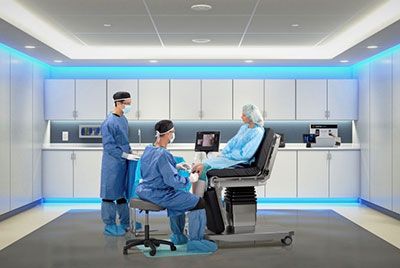Nanoscopic Surgery at Mammoth Orthopedic Institute Brian B. Gilmer, MD

Minimally invasive surgery has been the standard at the Mammoth Orthopedic Institute for years. Our team of highly skilled sports medicine surgeons remains on the cutting edge of arthroscopically repairing and replacing damaged tissues with a goal of the fastest and most complete recovery possible.
Arthroscopic surgery is where a small camera is inserted into a joint (“arthro” = joint, “scope” = camera). The joint is filled with a sterile water solution and instruments are placed through small incisions in order to examine and repair tissues as needed. The view from the camera is transmitted to a screen where the surgeon can see what is happening inside the joint.
Standard arthroscopic instruments are about the size of a drinking straw (4 mm) in diameter.
Nanoscopic (pronounced na·now) instruments are similar to arthroscopic instruments and also transmit a picture to a screen and allow for manipulation and repair of tissue, but these instruments are about half the size of arthroscopic instruments (2 mm) which is about the size of a strand of uncooked spaghetti. These instruments also use much less arthroscopic fluid which leads to less swelling during and after surgery.

These very small instruments have several potential advantages. In some cases, nanoscopy can be used while a patient is awake, under local anesthesia (numbing medicine in the skin), in order to provide a diagnosis when an MRI (a three dimensional image of the joint) is either not possible, not desired, or was inconclusive.

In other cases, entire surgeries can be performed nanoscopically under general (patient goes completely asleep) or local anesthesia with sedation (twilight sleep and numbing medication). Not all procedures are amenable to nanoscopic instrumentation, but when possible, the surgery can be performed with minimal to no incisions which are closed with only a specialized skin glue and band-aids. Patients can walk immediately after their procedure and start physical therapy with one of our highly trained therapists to ensure an optimal return to function.


Nanoscopic surgery is still very new. Mammoth Hospital was one of two facilities in California and among the first 15 in the nation to perform nanoscopic surgery. As our abilities and technologies improve we hope to expand the role of nanoscopic surgery to give patients a faster, less invasive, and less painful recovery.
For more information about nanoscopic surgery please feel free to contact us at our Mammoth or Bishop office or consider a remote consultation.








